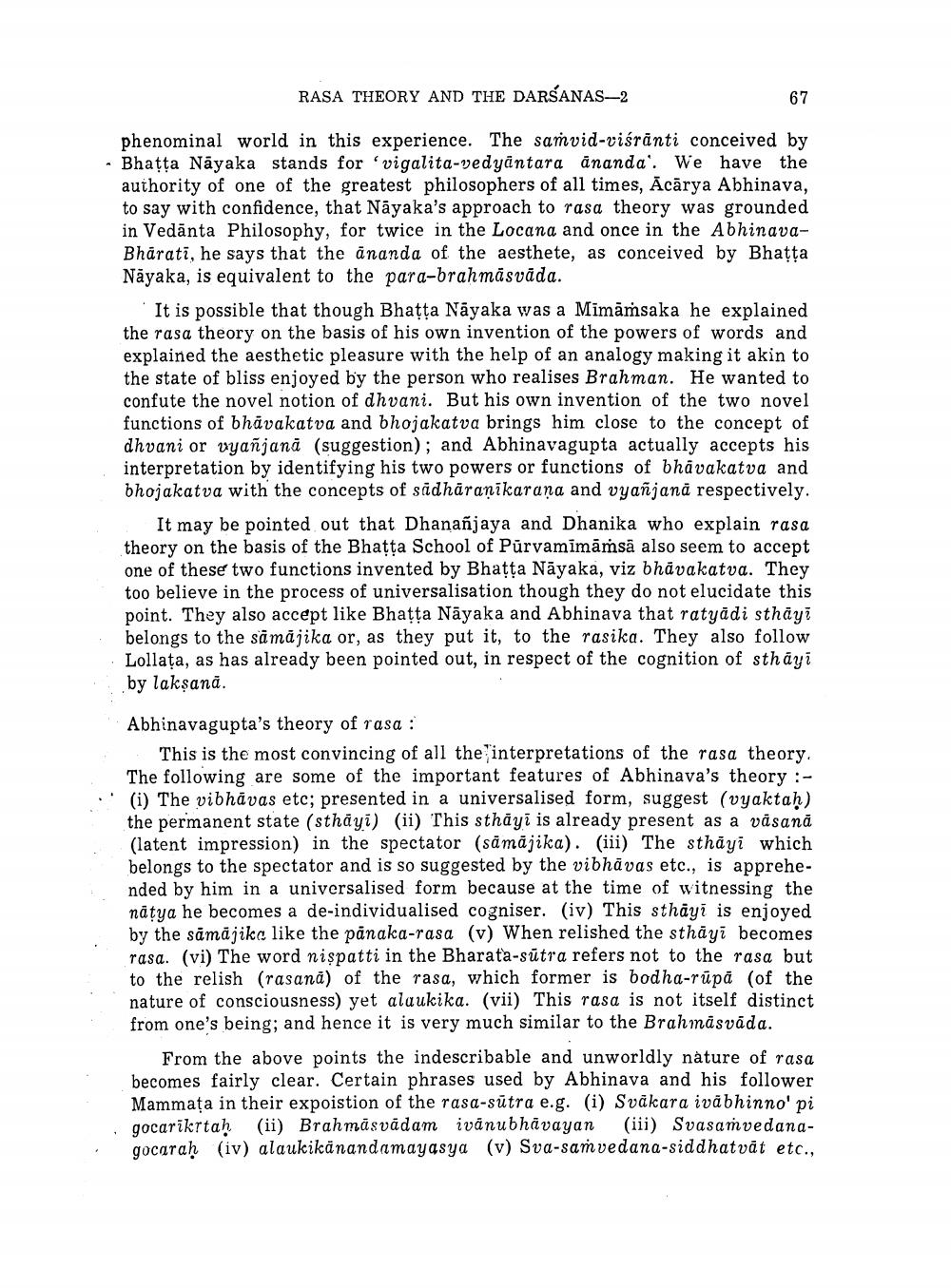________________
RASA THEORY AND THE DARŠANAS—2
phenominal world in this experience. The samvid-viśranti conceived by Bhatta Nayaka stands for 'vigalita-vedyantara ananda'. We have the authority of one of the greatest philosophers of all times, Ācārya Abhinava, to say with confidence, that Nāyaka's approach to rasa theory was grounded in Vedānta Philosophy, for twice in the Locana and once in the AbhinavaBharati, he says that the ananda of the aesthete, as conceived by Bhatta Nāyaka, is equivalent to the para-brahmāsvāda.
It is possible that though Bhatta Nayaka was a Mimāmsaka he explained the rasa theory on the basis of his own invention of the powers of words and explained the aesthetic pleasure with the help of an analogy making it akin to the state of bliss enjoyed by the person who realises Brahman. He wanted to confute the novel notion of dhvani. But his own invention of the two novel functions of bhavakatva and bhojakatva brings him close to the concept of dhvani or vyañjanā (suggestion); and Abhinavagupta actually accepts his interpretation by identifying his two powers or functions of bhāvakatva and bhojakatva with the concepts of sadharanikarana and vyañjană respectively.
It may be pointed out that Dhananjaya and Dhanika who explain rasa theory on the basis of the Bhatta School of Purvamīmāṁsā also seem to accept one of these two functions invented by Bhatta Nāyaka, viz bhāvakatva. They too believe in the process of universalisation though they do not elucidate this point. They also accept like Bhatta Nāyaka and Abhinava that ratyādi sthayi belongs to the samājika or, as they put it, to the rasika. They also follow Lollața, as has already been pointed out, in respect of the cognition of sthāyi by laksanā.
Abhinavagupta's theory of rasa :
This is the most convincing of all the interpretations of the rasa theory. The following are some of the important features of Abhinava's theory :(i) The vibhāvas etc; presented in a universalised form, suggest (vyaktah) the permanent state (sthayi) (ii) This sthāyī is already present as a vasana (latent impression) in the spectator (sāmājika). (iii) The sthāyi which belongs to the spectator and is so suggested by the vibhāvas etc., is apprehended by him in a universalised form because at the time of witnessing the natya he becomes a de-individualised cogniser. (iv) This sthāyī is enjoyed by the sāmājikc like the panaka-rasa (v) When relished the sthāyi becomes rasa. (vi) The word nispatti in the Bharata-sūtra refers not to the rasa but to the relish (rasana) of the rasa, which former is bodha-rūpā (of the nature of consciousness) yet alaukika. (vii) This rasa is not itself distinct from one's being; and hence it is very much similar to the Brahmāsvāda.
From the above points the indescribable and unworldly nature of rasa becomes fairly clear. Certain phrases used by Abhinava and his follower Mammața in their expoistion of the rasa-sūtra e.g. (i) Svakara ivābhinno' pi gocarikrtah (ii) Brahmāsvādam ivānubhavayan (iii) Svasamvedanagocaraḥ (iv) alaukikanandamayasya (v) Sva-samvedana-siddhatvāt etc.,




